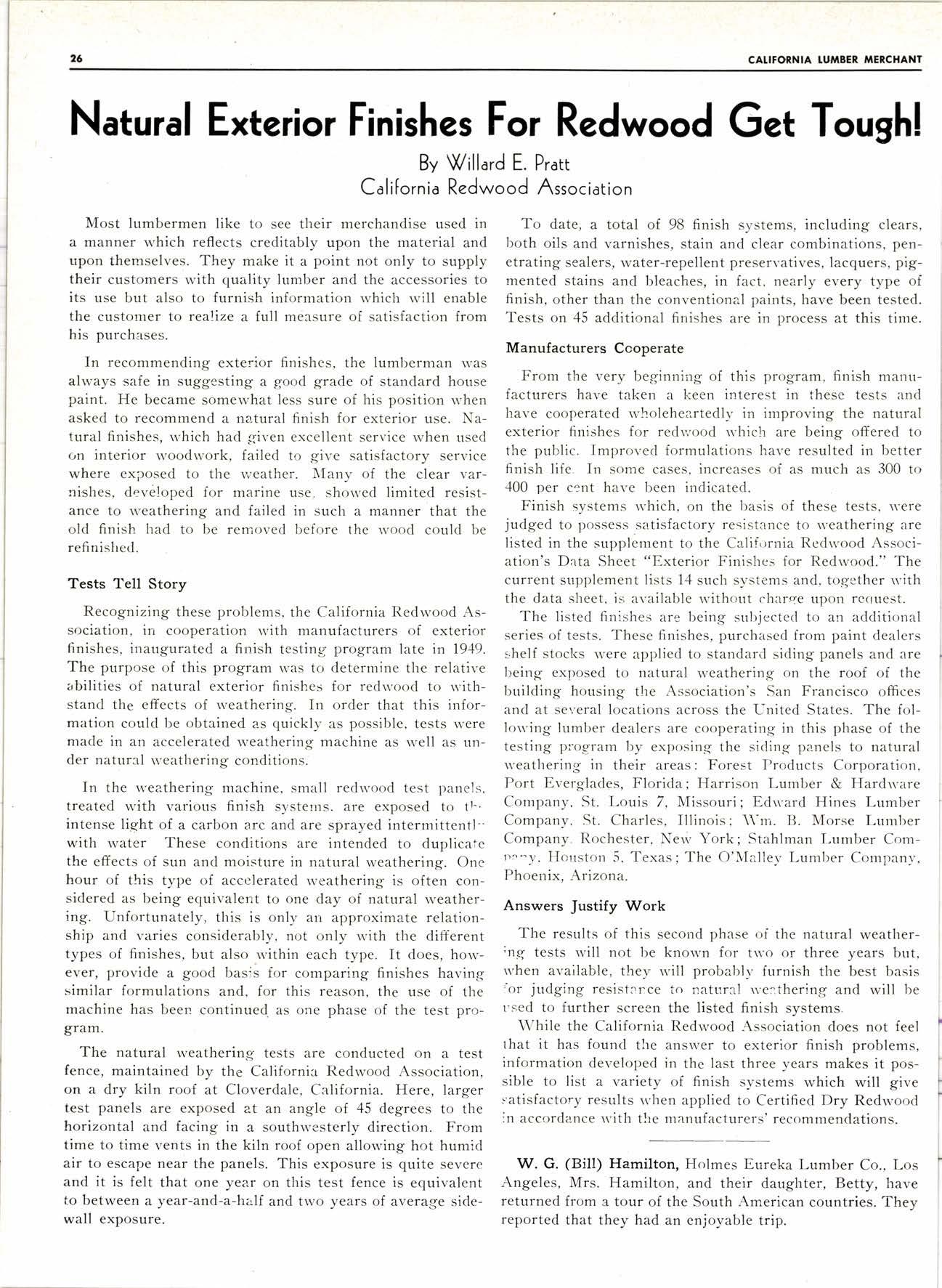
3 minute read
Natural Exterior Finishes For Redwood Get Tough!
Bv \(illard E. Pratt Colilornia Redwood Association
Most lumbermen like to see their merchandise used in a manner which reflects creditably upon the material and upon themselves. They make it a point not only to supply their customers with quality lumber and the accessories to its use but also to furnish information rvhich rvill enable the customer to real-rze a full mersure of satisfaction from his purchases.
In recommending exterior finishcs, the lumberman was always safe in suggesting a good grade of standard house paint. He became somewhat less sure of his position u'hen asked to recommend a na.tural finish for exterior use. Natural finishes, rvhich had given excellent service when used on interior u'oodwork, failed to give satisfactory service where exposed to the vu'eather. NIany of the clear varnishes, developed for marine use, shorved limited resistance to lveathering and failed in such a manner that the old finish had to be removed before the rvood could be refinished.
Tests Tell Story
Recognizing these problems, the California Redwood Association, in cooperation r,r'ith manufacturers of exterior finishes, inaugurated a finish testing program late in 1949. The purpose of this program \\'as to determine the relative abilities of natural exterior finishes for redn'ood to rvithstand the effects of rveathering. In order that this information could be obtained as quickly as possible, tests r,vere made in an accelerated l,veathering machine as rvell as under natur:rl n.eatl-rering conditions.
In the u'eathering machine, small redrvood test panels, treated with various finish systems. are exposed to tl'. intense lieht of a carbon arc and are sprayed intermittentl'' with water These conditions are intended to duplicate the effects of sun and moisture in natural weathering. One hour of this type of accelerated r.veathering is often considered as being equivalent to one day of natural rveatheri.tg. Unfortunately, this is only an approximate relationship and varies considerably, not only 'ivith the different types of finishes, but also u'ithin each type. It does, horvever, provide a good bas:s for comparing finishes having similar formulations and, for this reason, the use of the machine has been continued as one ohase of the test program.
The natural weathering tests are conducted on a test fence, maintained by the California Redwood Association, on a dry kiln roof at Cloverdale, Celifornia. Here, larger test panels are exposed at an angle of 45 degrees to the horizontal and facing in a southwesterly direction. From time to time vents in the kiln roof open allowing hot humid air to escape near the panels. This exposure is quite severe and it is felt that one year on this test fence is equivalent to between a year-and-a-hzilf and trvo years of average sidewall exposure.
To date, a total of 98 finish systems, including clears, both oils and varnishes, stain and clear combinations, penetrating sealers, water-repellent preservatives, lacquers, pigmented stains and ltleaches, in fact, nearly every type of finish, other than the conventional paints, have been tested. Tests on 45 additional finishes are in process at this time.
Manufacturers Cooperate
From the very beginning of this program, finish manufacturers have taken a keen interest in these tests :rnd l-rave cooperated l'holeheartedly in improving the natural exterior finishes for redr,"'ood u'hich are being offered to the public. Improved formulations have resulted in better finish life In some cases. increases of as much as 300 to 400 per cent have been indicated.
Finish systems lvhich, on the basis of these tests, n'ere judged to possess satisfactory resistance to weathering are listed in the supplement to the Caliiornia Redu'ood Association's Data Sheet "Exterior Finishes for Redrvood." The current supplement lists 14 such systems and, together u'ith the data sheet, is available vvithorrt charqe upon recruest. The listed finishes are being subjected to an additional series of tests. These finishes, purch:tsed from paint dealers s.helf stocks \vere applied to standard siding panels and are being exposed to natural u,'eathering on the roof of the building housing tl.re Association's San Francisco offices and at se...eral locations across the United States. The follou'ing lumber dealers are cooperating in this phase of the testing pl'osram by exposing the siding panels to natural rveatl.rering in their areas: Forest Products Corporation, Port Everglades, Florida; Harrison Lumber & Hardl.are Company. St. Louis 7, Missouri; Edu'ard Hines Lumber Company, St. Charles, Illinois; \\'n-,. B. Morse Lumlter Company. Rochester, Nerv York; Stahlman l,umber Com1-r"y. Horrston 5, Texas; The O'N{allev I-umlter Companl', Phoenix, Arizona.
Answers Justify Work
The results of this second phase of the natural weather;ng tests r,vill not lte knolvn for trvo or three years but, u'hen available, they u'ill probably furnish the best basis ior judging resistrrce to naturrl n-ei.thering and will be r.sed to further screen the listed finish systems.
While the California Redwood Association does not feel that it has found the ansrver to exterior finish problems, information developed in the last three years makes it possible to list a variety of finish systems which will give satisfactory results u'hen applied to Certified Dry Redu'ood in accordance rr'ith the manufacturers' recommendations.
W. G. (Bill) Hamilton, Holmes Eureka Lumber Co., Los Angeles, Mrs. Hamilton, and their daughter, Betty, have returned from a tour of the South American countries. They reported that they had an cn.ioyable trip.










